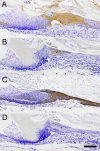Cutaneous hybrid cyst in a sprague-dawley rat
- PMID: 22907984
- PMCID: PMC3392906
- DOI: 10.1293/tox.25.175
Cutaneous hybrid cyst in a sprague-dawley rat
Abstract
This report describes a spontaneous hybrid cyst in a Sprague-Dawley (SD) rat. A 52-week-old, male SD rat had a cutaneous cyst on the left mystacial pad. Histologically, the cyst wall showed infundibular differentiation with keratohyalin granules in the granular layer and matrical differentiation comprising basaloid epithelial cells with trichohyalin granules. The cyst cavity was filled with lamellar, flaky keratin and aggregates of shadow cells. Immunohistochemically, the infundibular-type epithelium was positive for cytokeratin (CK) AE1/AE3, CK KL1 and CK14 but negative for CK15, whereas the matrical-type epithelium was negative for all four CK isoforms examined. These immunohistochemical properties of the infundibular- and matrical-type epithelia were similar to those of the infundibulum and inferior segment of normal hair follicles, respectively. Based on these findings, the cyst was diagnosed as a hybrid cyst, comprising more than one type of cyst arising from various parts of the pilosebaceous unit.
Keywords: Sprague-Dawley rat; cytokeratin; epidermal inclusion cyst; hybrid cyst; kin.
Figures



Similar articles
-
Hybrid follicular cyst (pilomatrical and infundibular) arising within a sebaceous nevus.Pediatr Dermatol. 2012 Mar-Apr;29(2):213-6. doi: 10.1111/j.1525-1470.2011.01404.x. Epub 2011 Mar 25. Pediatr Dermatol. 2012. PMID: 21438919
-
Cutaneous Epithelial Lesions Induced by N-Methyl-N-nitrosourea in Male Sprague-Dawley Rats: A Possible Animal Model for Human Keratoacanthoma.Anticancer Res. 2016 Jan;36(1):111-20. Anticancer Res. 2016. PMID: 26722034
-
Follicular hybrid cysts. An expanded spectrum.Am J Dermatopathol. 1991 Jun;13(3):228-33. doi: 10.1097/00000372-199106000-00003. Am J Dermatopathol. 1991. PMID: 1714246 Review.
-
Existence of trichohyalin-keratohyalin hybrid granules: co-localization of two major intermediate filament-associated proteins in non-follicular epithelia.Differentiation. 1994 Nov;58(1):65-75. doi: 10.1046/j.1432-0436.1994.5810065.x. Differentiation. 1994. PMID: 7532602
-
Keratohyalin, trichohyalin and keratohyalin-trichohyalin hybrid granules: an overview.J Dermatol. 1992 Nov;19(11):749-55. doi: 10.1111/j.1346-8138.1992.tb03774.x. J Dermatol. 1992. PMID: 1284067 Review.
References
-
- Stephen G, Lake LH-E, Robert EM, Barry PS. Nonneoplaspic lesions. In: Integument and Mammary Glands (Monographs on Pathology of Laboratory Animals), Springer-Verlag, Heidelberg, Germany. 130–157. 1989
-
- Goldschmidt MH, Dunstan RW, Stannard AA. Cyst. In: Histological Classifcation of Epithelial and Melanocytic Tumors of the Skin of Domestic Animals, Armed Forces Institute of Pathology, Washington DC, USA. 33–35. 1998
-
- Gross TL, Ihrke PJ, Walder EJ, Affolter VK. Follicular Tumors. In: Skin Diseases of the Dog and Cat, 2nd ed. TL Gorss, PJ Ihrke, EJ Walder, and VK Affolter (eds). Blackwell Publishing, Oxford, UK. 604–640. 2005
-
- Brownstein MH. Hybrid cyst: a combined epidermoid and trichilemmal cyst. J Am Acad Dermatol. 9: 872–875 1983. - PubMed
-
- McGavran MH, Binnington B. Keratinous cysts of the skin. Identification and differentiation of pilar cysts from epidermal cysts. Arch Dermatol. 94: 499–508 1966. - PubMed
LinkOut - more resources
Full Text Sources
Research Materials
Miscellaneous
